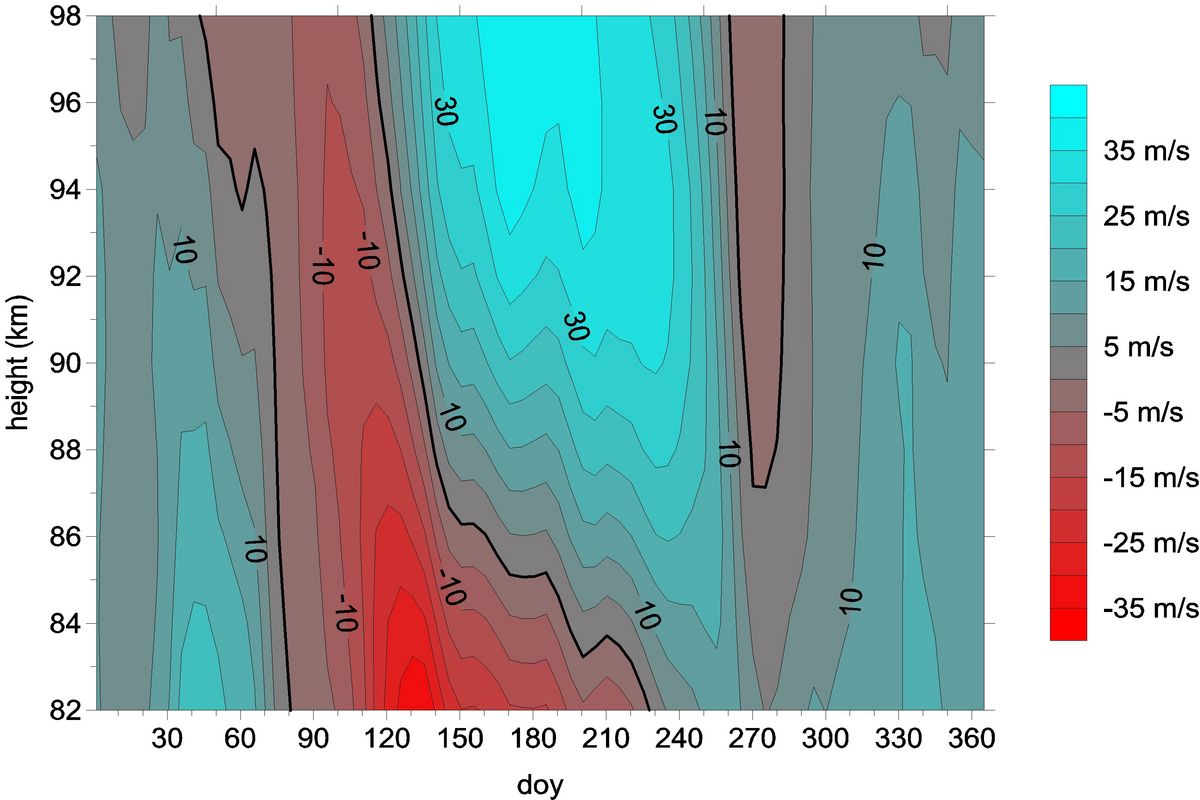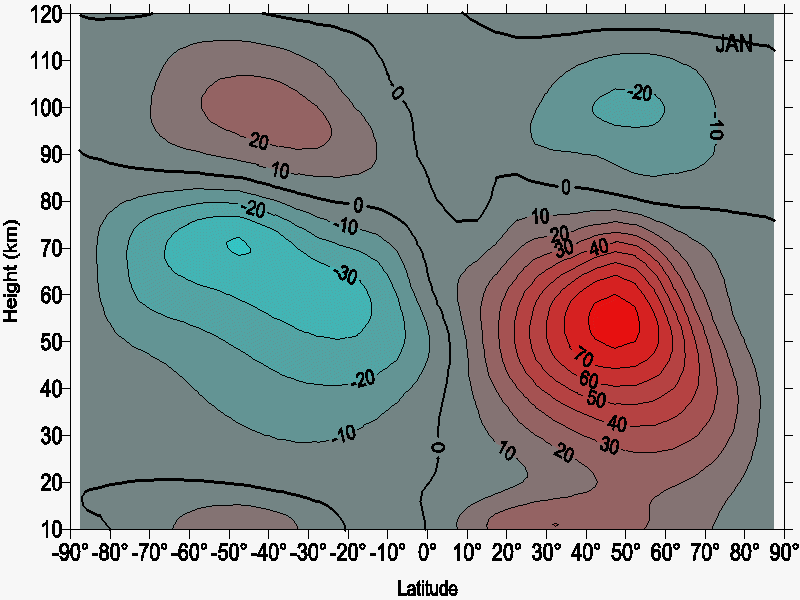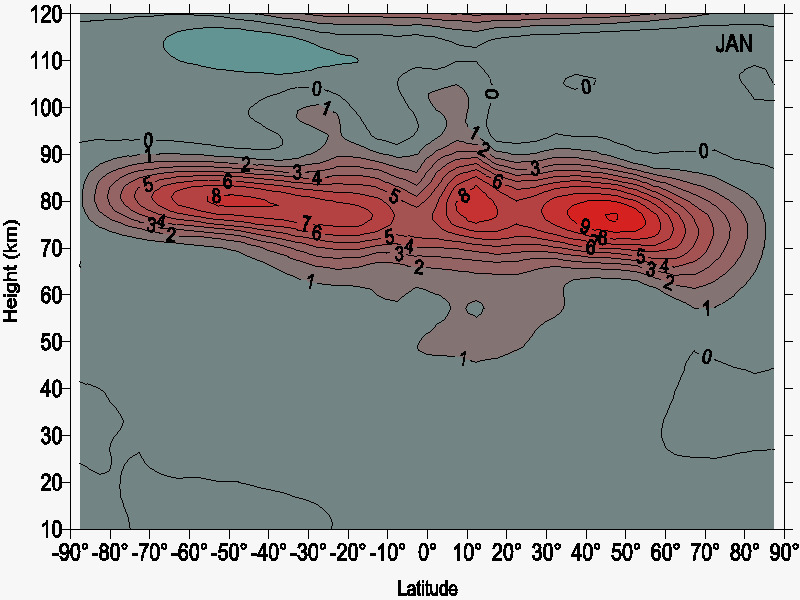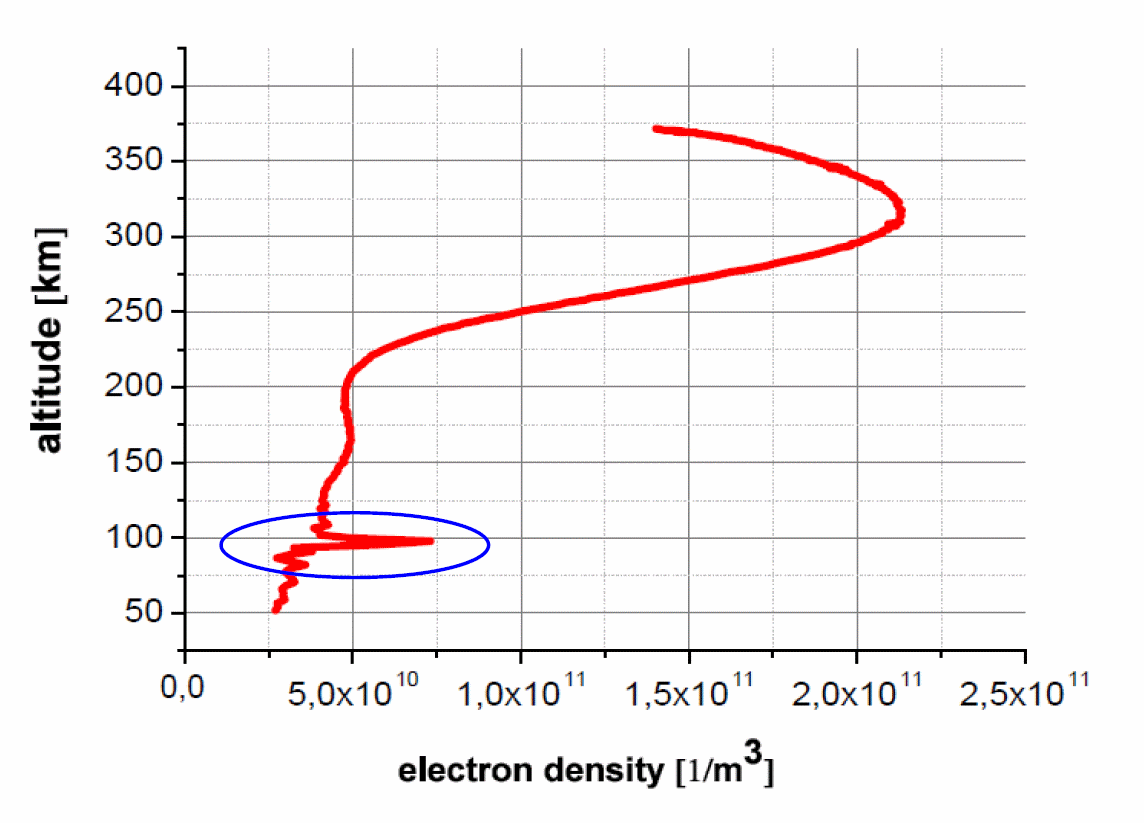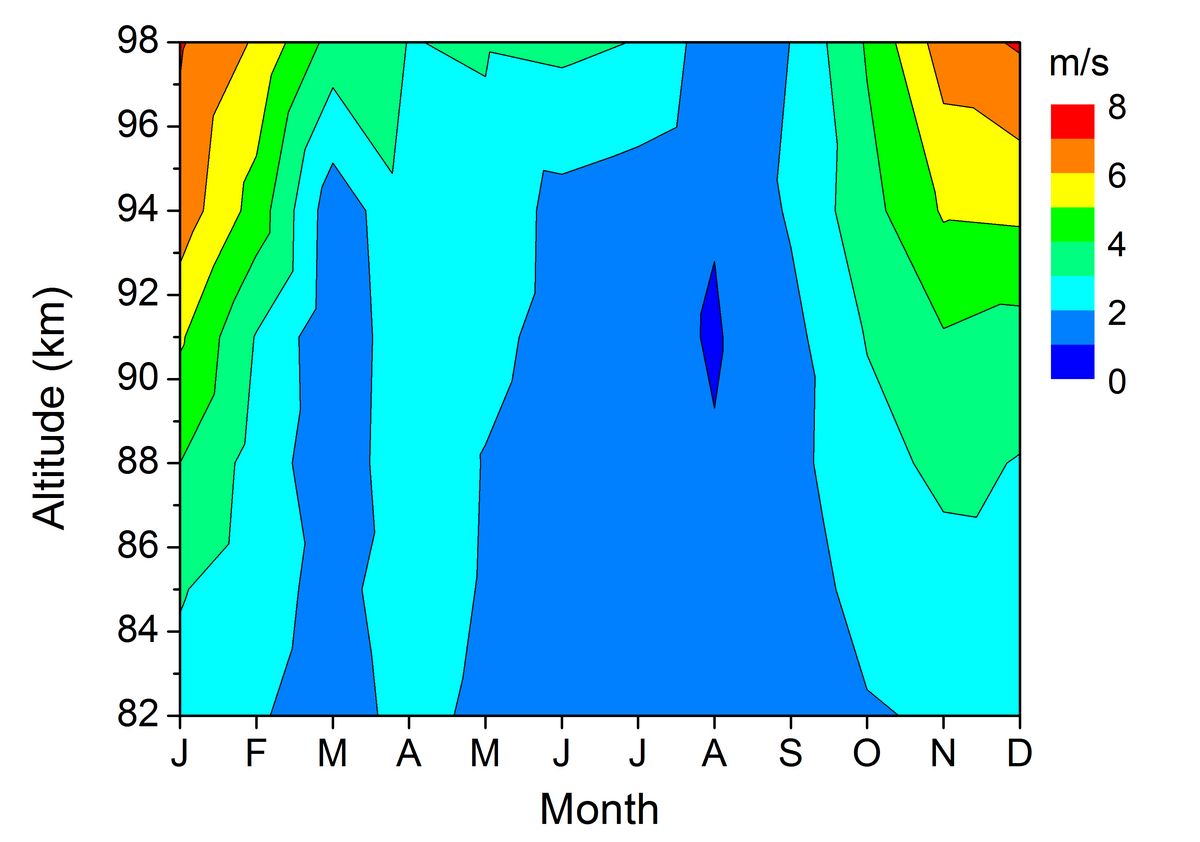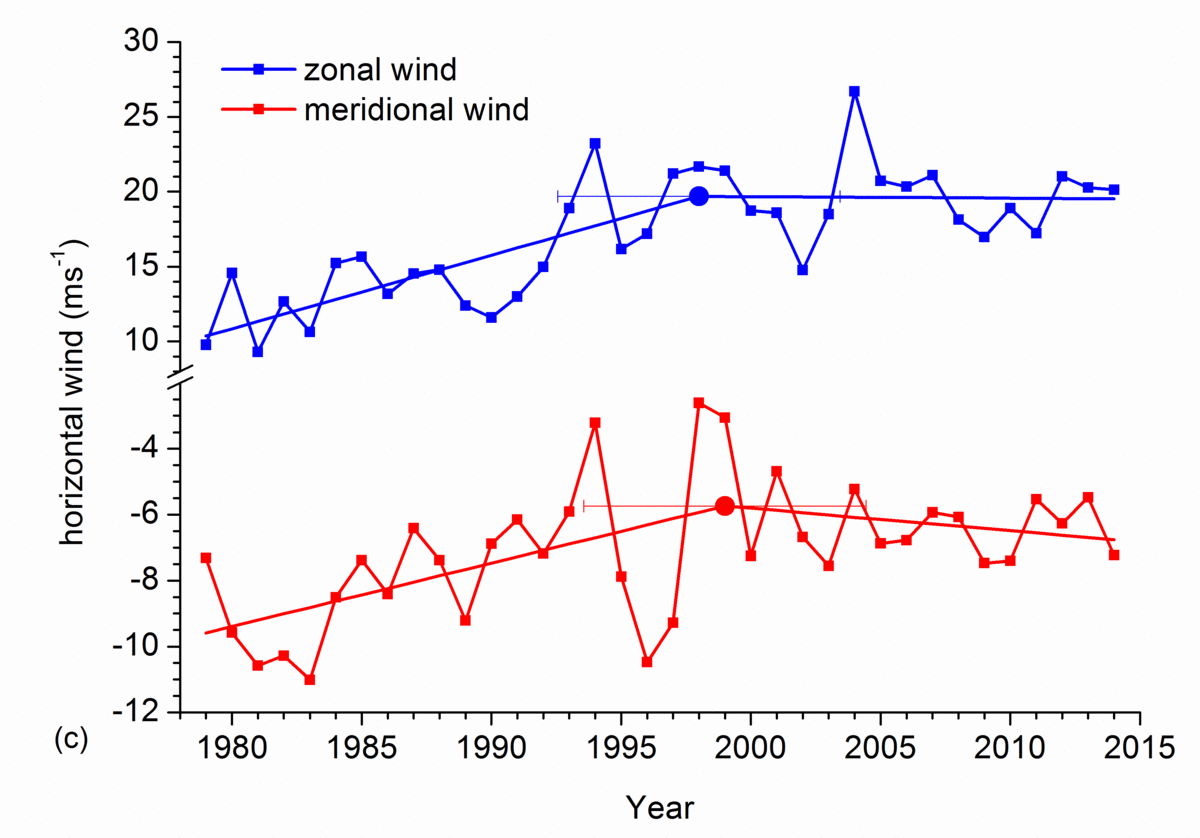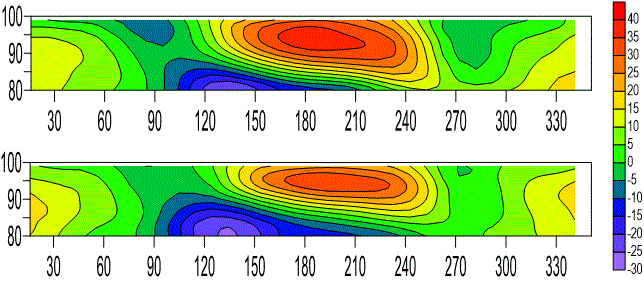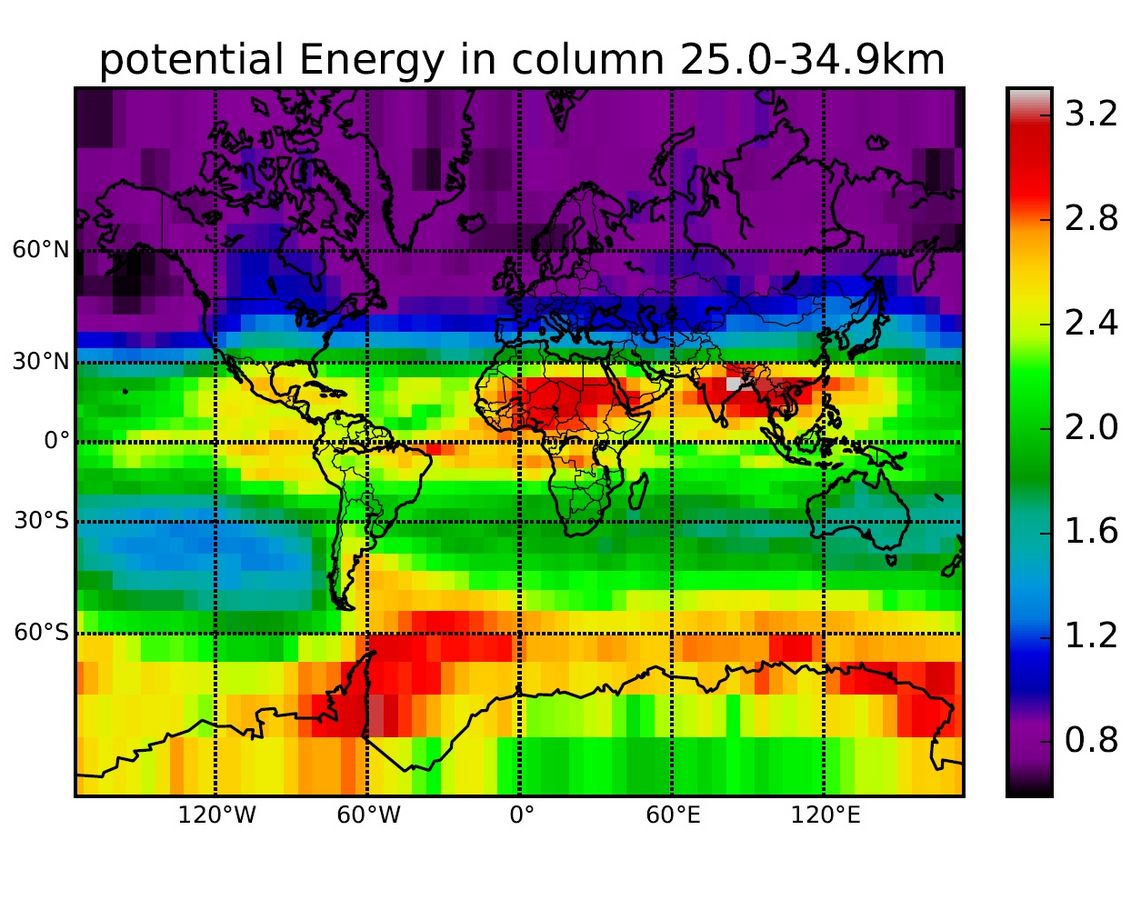The working group Meteorology of Middle and Upper Atmosphere studies the entire middle and upper atmosphere, i.e. stratosphere, mesosphere, and thermosphere/ionosphere. The investigations also include the coupling of these layers with the lower atmosphere, and the connection with meteorological processes, as well as coupling processes between the neutral and ionized atmosphere.
Current Research Projects
The projects listed below are subprojects of joint projects funded by the German Research Foundation, projects for temporary positions funding by the German Research Foundation and projects funded by the institute.
Arctic Amplification: Climate Relevant Atmospheric and Surface Processes, And Feedback Mechanisms
Funding: German Research Council
Project period: 01.01.2016 – 31.12.2027
Planet earth has warmed on average by 0.87 K over the past 150 years. In the Arctic, the warming is much larger, which became most prominent over the last decades. Currently, the Arctic warming exceeds the increase of near-surface air temperature in the mid-latitudes by about 2 K. This phenomenon is commonly referred to as Arctic amplification.
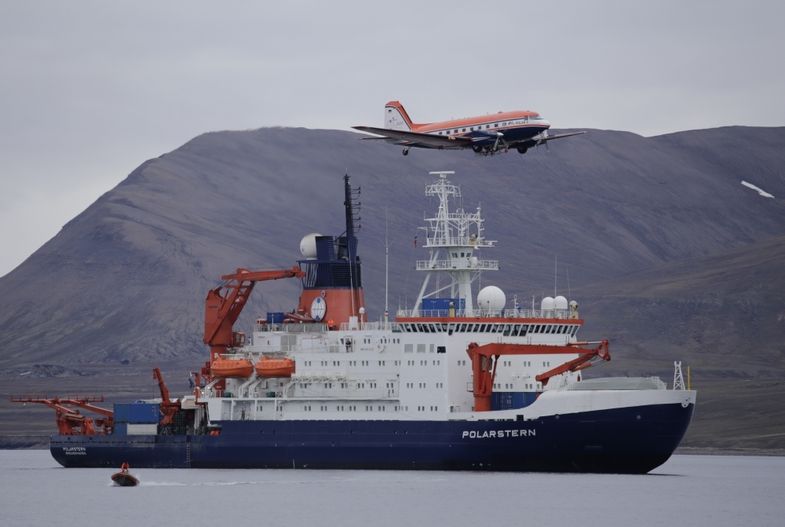
- Subproject D01 - Large Scale Dynamical Mechanisms of Arctic amplification
Team: Prof. Dr. Johannes Quaas (PI), Prof. Dr. Christoph Jacobi (PI), Sina Mehrdad
The causes and consequences of exceptionally strong stratospheric polar vortices and the associated ozone holes: from seasonal to seasonal to long-term effects (ENRICH)
Funding: German Research Council
Project period: 01.05.2023 – 30.04.2026
Team: Anish Kumar, Dr. Khalil Karami
While the ozone hole develops over the Antarctic every year during austral spring, the conditions that are required for such substantial ozone depletion are not normally found in the Arctic during boreal spring (WMO [World Meteorological Organization], Scientific Assessment of Ozone Depletion, 2018). However, there are a few notable exceptions to this paradigm. For example, Manney et al. (2011) and Sinnhuber et al. (2011) reported that the Arctic ozone concentrations were at the brink of an ozone hole during winter 2010/2011 which was mainly due to the stable and cold Arctic polar vortex during that season.
Objectives
Our research aims to investigate the causes and consequences of exceptionally cold and stable Arctic polar vortices and their associated ozone holes during winter/spring 2011 and 2020. The project will use the ICON (ICOsahedral Non-hydrostatic model) atmospheric model inconjunction with the ART module (Aerosols and Reactive Trace gases, Rieger et al. 2015) with different simulation setups (time-slice experiments, interactive and non-interactive stratospheric chemistry, with and without ozone-depleting substances (ODSs)). In addition, extensive use of complementary data is planned: CMIP6 model simulations, reanalysis data (ERA5 and MERRA) and GPS radio occultation observations (COSMIC, COSMIC-2a and CHAMP). The GPS observations will be used to estimate the amplitude of the gravity wave in the stratosphere prior
and during winter/spring 2011 and 2020. In addition, the ICON-ART results and reanalysis data are separated into the balanced (Rossby) and and inertio-gravity (IG) circulations across many scales using the MODES software (Žagar et al, 2015). We hypothesize that either the anomalous injection of the upward propagating waves (both resolved Rossby waves and unresolved gravity waves) or the anomalous geometry of the polar vortex led to such anomalous ozone hole conditions during winter/spring 2011 and 2020. Additionally, we hypothesize that using interactive chemistry is essential to capture the full spectrum of the stratospheric variability, which is critical to capturing the downward influence of the stratospheric polar vortex on the troposphere.
The objectives of the project can be summarized in the following research questions (RQ 1-4):
(1) To what extend has climate change contributed to the formation of exceptionally strong polar vortices and associated ozone holes in winter/spring 2011 and 2020?. What is the fate of such extreme events under climate change?
(2) What would have happened to ENRICH-like events under future climate projections, in the coming decades, if the negotiation and ratification of the Montreal Protocol had not been implemented (World Avoided scenario)?
(3) What are the relative contributions of dynamical (balanced (Rossby) mode versus inertiagravity mode) forcing versus chemical/thermodynamic changes in the formation of the extreme polar vortices in present and future climate?
(4) What are the consequences of such extreme stratospheric situations (strong polar vortex and low/depleted ozone in the NH) for tropospheric weather?
Delayed response of the ionosphere to solar EUV II variability (DRIVAR II)
Funding: German Reseach Foundation
Period: 01.05.2022 – 31.04.2025
Team: Dr. Rajesh Ishwardas Vaishnav, Prof. Dr. Christoph Jacobi
Cooperation partner: German Aresospace Center (DLR) - Institute of Communications and Navigation
The ionospheric plasma reacts on solar EUV and UV variations in the course of the solar rotation with a time delay of 1-2 days. This delay is assumed to be owing to transport processes from the lower ionosphere to the F region, but only limited modeling has been performed so far to prove this hypothesis.
Within DRIVAR, the processes responsible for the ionospheric delay will be investigated through comprehensive data analyses and modeling. Different kinds of solar proxies as well as spectral EUV and UV fluxes from satellite observations will be used and analyzed together with ionospheric parameters from GPS radio occultations and ionosondes, and, providing both global and high-resolution coverage, GPS total electron content maps. In particular, the ionospheric delay will be analyzed at different time scales (short-term, solar rotation, seasonal time scale), and the regional dependence of the delay will be analyzed.
Local gravity wave forcing on the middle atmosphere: formation, effects, and long-term trends
Funding: German Research Foundation (DFG)
Project period: 01.05.2021 – 31.10.2024
Team: Dr. Khalil Karami, Prof. Dr. Christoph Jacobi
Cooperation partners: Department of Atmospheric Physics, Faculty of Mathematics and Physics, Charles University in Prague, Czech Republic (DAP).
The MATELO-FILE project focuses on the detection, analysis, and modelling of stratospheric gravity wave (GW) hotspotsand their effect on the dynamics of the middle atmosphere. To this end, we willidentify GWhotspotson the basis of observations,reanalysis dataand model output by analysing different GW parameters, and also background conditions. From these analyseswe will deduce possible GW sources as well as meteorological conditionsthatfavour the generation of GWhotspots. Based on these results fromthe datasets partly covering several decades, we will also investigate the temporal development of these GW hotspots to investigatein how far the GW hotspot activity has changed during the last decades. To analysethe interactionprocessesof these GW hotspots with the circulation of the middle atmosphere (the wave forcing itself as well as a compensation mechanism), experiments with the UA-ICON global circulation model and a further mechanistic circulation modelwill be performed. This will enable us toinvestigate (i) howthe GW hotspots and their effects are reproduced in climate models, (ii) their influence on circulation changes in a changing climate, and (iii) how they react on a changing climate.
Meteor Radar Winds and Wind Observation over Collm
Cooperation partner: Institute of Amtospheric Physics, Kühlungsborn
The mesosphere/lower thermosphere (MLT) is one of the scientifically most challenging regions of the atmosphere. The MLT is the region where wave-wave and wave-mean flow interaction processes lead to a mean circulation regime that is extremely far from radiative equilibrium. Although radar measurements of MLT winds are possible since more than half a century, our current knowledge on MLT dynamics is still far from complete, mostly due to incomplete coverage of the global wind field by ground-based remote sensing system.
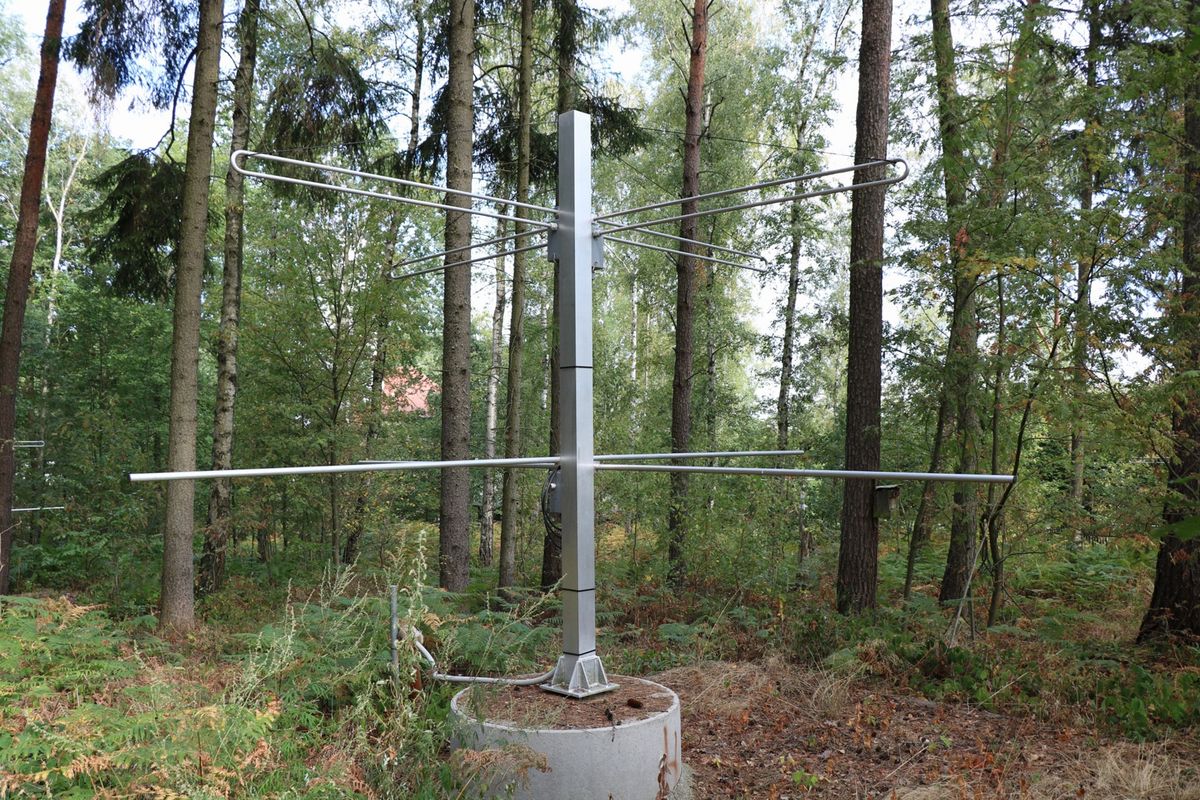
As a contribution to our knowledge of MLT dynamics a SKiYMET meteor radar is operated at Collm Observatory (51.3°N, 13°E) continuously since August 2004. The measurements deliver hourly wind information in the height range 80-100 km and daily mean temperatures near the mesopause. Together with the earlier LF wind measurements peformed at Collm 1959 - 2008 a unique MLT circulation parameter dataset is available.
Recently, the MMARIA (Multi-static, Multifrequency Agile Radar for Investigations of the Atmosphere) concept of a multi-static VHF meteor radar network to derive horizontally resolved wind fields in the mesosphere–lower thermosphere was introduced, using two transmitters located at Juliusruh and Collm, and several receiving links (Stober et al., 2018). This allows to retrieve horizontally resolves winds over Eastern Germany.
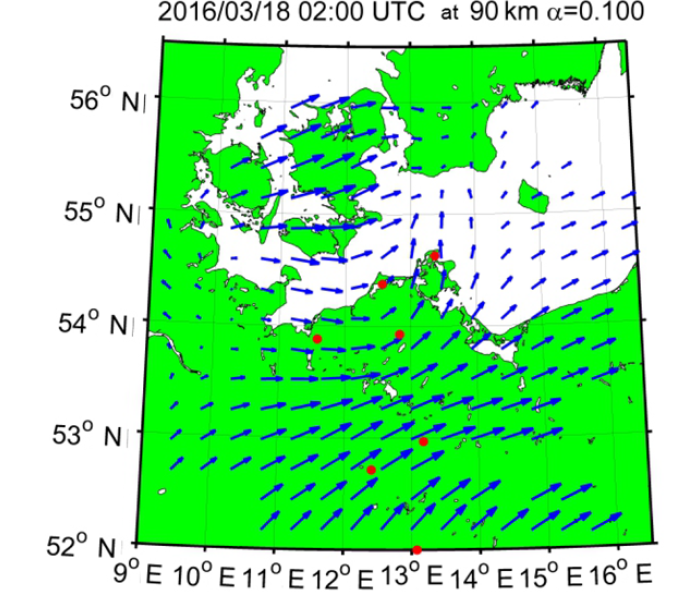
Selected publications:
- Jacobi, Ch., C. Geißler, F. Lilienthal, and A. Krug, 2018: Forcing mechanisms of the 6-hour tide in the mesosphere/lower thermosphere, Adv. Radio Sci., 16, 141-147, doi:10.5194/ars-16-141-2018.
- Stober, G., J.L. Chau, J. Vierinen, J., Ch. Jacobi, and S. Wilhelm, 2018: Retrieving horizontally resolved wind fields using multi-static meteor radar observations, Atmos. Meas. Tech., 11, 4891-4907, doi:10.5194/amt-11-4891-2018.
- Jacobi, Ch., A. Krug, and E. Merzlyakov, 2017: Radar observations of the quarterdiurnal tide at midlatitudes: Seasonal and long-term variations, J. Atmos. Sol.-Terr. Phys., 163, 70-77, doi:10.1016/j.jastp.2017.05.014.
- Jacobi, Ch., T. Ermakova, D. Mewes, and A.I. Pogoreltsev, 2017: El Niño influence on the mesosphere/lower thermosphere circulation at midlatitudes as seen by a VHF meteor radar at Collm (51.3°N, 13°E), Adv. Radio Sci., 15, 199-206, doi:10.5194/ars-15-199-2017.
- Stober, G., V. Matthias, Ch. Jacobi, S. Wilhelm, J. Höffner und J. L. Chau, 2017: Exceptionally strong summer-like zonal wind reversal in the upper mesosphere during winter 2015/16, Ann. Geophys., 35, 711-720, doi:10.5194/angeo-35-711-2017
- Wu, Q., A. Maute, V. Yudin, L. Goncharenko, J. Noto, R. Kerr, and C. Jacobi, 2016: Observations and Simulations of Mid Latitude Ionospheric and Thermospheric Response to the January 2013 Stratospheric Sudden Warming Event, J. Geophys. Res. Space Physics, 121, 8995–9011, doi:10.1002/2016JA023043.
- Jacobi, Ch., F. Lilienthal, C. Geißler, and A. Krug, 2015: Long-term variability of mid-latitude mesosphere-lower thermosphere winds over Collm (51°N, 13°E), J. Atmos. Sol.-Terr. Phys., 136, B, 174–186, doi:10.1016/j.jastp.2015.05.006.
- Lilienthal, F., and Ch. Jacobi, 2015: Meteor radar quasi two-day wave observations over 10 years at Collm (51.3°N, 13.0°E), Atmos. Chem. Phys., 15, 9917-9927, doi:10.5194/acp-15-9917-2015.
- Jacobi, Ch., 2014: Meteor heights during the recent solar minimum, Adv. Radio Sci., 12, 161-165. doi:10.5194/ars-12-161-2014
- Jacobi, Ch., C. Arras, and J. Wickert, 2013: Enhanced sporadic E occurrence rates during the Geminid meteor showers 2006-2010, Adv. Radio Sci., 11, 313–318, 2013, doi:10.5194/ars-11-313-2013.
- Stober, G., Ch. Jacobi, V. Matthias, P. Hoffmann, and M. Gerding, 2012: Neutral air density variations during strong planetary wave activity in the mesopause region derived from meteor radar observations. J. Atmos. Sol.-Terr. Phys., 74, 55-63, doi:10.1016/j.jastp.2011.10.007
- Jacobi, Ch., 2012: 6 year mean prevailing winds and tides measured by VHF meteor radar over Collm (51.3°N, 13.0°E). J. Atmos. Solar-Terr. Phys., 78–79, 8–18, doi:10.1016/j.jastp.2011.04.01.
- Placke, M., P. Hoffmann, E. Becker, Ch. Jacobi, W. Singer, and M. Rapp, 2011: Gravity wave momentum fluxes in the MLT – Part II: Meteor radar investigations at high and midlatitudes in comparison with modeling studies. J. Atmos. Solar–Terr. Phys., 73, 911-920, doi:10.1016/j.jastp.2010.05.007.
- Placke, M., G. Stober, and Ch. Jacobi, 2011: Gravity wave momentum fluxes in the MLT—Part I: Seasonal variation at Collm (51.3°N, 13.0°E). J. Atmos. Solar–Terr. Phys., 73, 904-910, doi:10.1016/j.jastp.2010.07.012.
- Stober, G., Ch. Jacobi, and W. Singer, 2011: Meteoroid mass determination from underdense trails. J. Atmos. Solar-Terr. Phys., 73, 895-900, doi:10.1016/j.jastp.2010.06.009.
- Arras, C., Ch. Jacobi, and J. Wickert, 2009: Semidiurnal tidal signature in sporadic E occurrence rates derived from GPS radio occultation measurements at midlatitudes. Ann. Geophys. 27, 2555–2563.
- Jacobi, Ch., C. Arras, D. Kürschner, W. Singer, P. Hoffmann, and D. Keuer, 2009: Comparison of mesopause region meteor radar winds, medium frequency radar winds and low frequency drifts over Germany. Adv. Space. Res., 43, 247-252.
Numerical simulation of Middle atmosphere dynamics at Leipzig Institute of Meteorology
Cooperation:
At Leipzig Institute of Meteorology, numerical simulation of the middle atmosphere is performed using mechanistic circulation models including dynamics, radiative processes and energy and momentum sources connected with middle and upper atmosphere processes.
Models used are global scale and cover the atmosphere from the ground to the thermosphere. Gravity wave parameterisation is included, and planetary waves are forced included through direct forcing at the lower boundary, or through assimilation of global datasets in the troposphere/stratosphere.
Publications related to the project:
- Lilienthal, F., Ch. Jacobi, and C. Geißler, 2018: Forcing mechanisms of the terdiurnal tide, Atmos. Chem. Phys. Discuss., doi:10.5194/acp-2018-154, in review.
- Jacobi, Ch., C. Geißler, F. Lilienthal und A. Krug, 2018: Forcing mechanisms of the 6-hour tide in the mesosphere/lower thermosphere , Adv. Radio Sci., in print.
- Jacobi, Ch., T. Ermakova, D. Mewes, and A.I. Pogoreltsev, 2017: El Niño influence on the mesosphere/lower thermosphere circulation at midlatitudes as seen by a VHF meteor radar at Collm (51.3°N, 13°E), Adv. Radio Sci., 15, 199-206, doi:10.5194/ars-15-199-2017.
- Lilienthal, F., Ch. Jacobi, T. Schmidt, A. de la Torre, and P. Alexander, 2017: On the influence of zonal gravity wave distributions on the Southern Hemisphere winter circulation, Ann. Geophys., 35, 785-798, doi:0.5194/angeo-35-785-2017.
- Jacobi, Ch., F. Lilienthal, C. Geißler, and A. Krug, 2015: Long-term variability of mid-latitude mesosphere-lower thermosphere winds over Collm (51°N, 13°E), J. Atmos. Sol.-Terr. Phys., 136, B, 174–186, doi:10.1016/j.jastp.2015.05.006
- Merzlyakov, E.G., Ch. Jacobi, and T.V.Solovjova, 2015: The year-to-year variability of the autumn transition dates in the mesosphere/lower thermosphere wind regime and its coupling with the dynamics of the stratosphere and troposphere, J. Atmos. Sol.-Terr. Phys., 122, 9-17, doi:10.1016/j.jastp.2014.11.002
- Fytterer, T., C. Arras, P. Hoffmann, and Ch. Jacobi, 2014: Global distribution of the migrating terdiurnal tide seen in sporadic E occurrence frequencies obtained from GPS radio occultations, Earth, Planets and Space, 66:79, . doi:10.1186/1880-5981-66-79
- Jacobi, Ch., K. Fröhlich, Y. Portnyagin, E. Merzlyakov, T. Solovjova, N. Makarov, D. Rees A. Fahrutdinova, V. Guryanov, D. Fedorov, D. Korotyshkin, J. Forbes, A. Pogoreltsev, and D. Kürschner, 2009: Semi-empirical model of middle atmosphere wind from the ground to the lower thermosphere. Adv. Space Res., 43, 239-246, doi:10.1016/j.asr.2008.05.011.
- Pogoreltsev, A.I., A.A. Vlasov. K. Fröhlich, and Ch. Jacobi, 2007: Planetary waves in coupling the lower and upper atmosphere. J. Atmos. Solar-Terr. Phys. 69, 2083-2101.
- Fröhlich, K., T. Schmidt, M. Ern, P. Preusse, A. de la Torre, J. Wickert, and Ch. Jacobi, 2007: The global distribution of gravity wave energy in the lower stratosphere derived from GPS data and gravity wave modelling: attempt and challenges. J. Atmos. Solar-Terr. Phys. 69, 2238–2248. Jacobi, Ch., N. Jakowski, A. Pogoreltsev, K. Fröhlich, P. Hoffmann, and C. Borries, 2007: The CPW-TEC project: Planetary waves in the middle atmosphere and ionosphere. Adv. Radio Sci. 5, 393–397, doi:10.5194/ars-5-393-2007
- Fröhlich, K., A. I. Pogoreltsev, Ch. Jacobi and L.A. Nechaeva, 2007: The influence of NCEP-data assimilated into COMMA-LIM on the 16-day wave. Wiss. Mitt. Inst. Meteorol. Univ. Leipzig 41, 37-45.
- Jacobi, Ch., A.I. Pogoreltsev, and K. Fröhlich, 2006: Middle atmosphere background climatology from a simple circulation model. Adv. Space Res., 38, 2470-2474.
- Jacobi, Ch., K. Fröhlich, and A. Pogoreltsev, 2006: Quasi two-day-wave modulation of gravity wave flux and consequences for the planetary wave propagation in a simple circulation model. J. Atmos. Solar-Terr. Phys., 68, 283-292.
- Fröhlich, K., Ch. Jacobi, und A.I. Pogoreltsev, 2005: Planetary wave transience effects on the zonal mean flow. Adv. Space Res., 35, 1900-1904.
- Jacobi, Ch., M. Lange and D. Kürschner, 2003: Influence of anthropogenic climate gas changes on the summer mesospheric/lower thermospheric meridional wind. Meteorol. Z., N.F. 12, 37-42.
Sporadic E (Es) layers
Sporadic E (Es) layers are thin clouds of accumulated plasma, primarily occurring at midlatitudes during summer. They are generally formed at altitudes between 90 km and 120 km, which is equivalent to the upper MLT and the lower ionospheric E region. According to wind shear theory the forming process of Es is an interaction between the Earth's magnetic field, the ion concentration as well as the vertical wind shear.
At Deutsches GeoForschungsZentrum (GFZ) Potsdam, Es occurrence rates are derived from GPS radio occultations. These data are used mainly to analyse the influence of neutral dynamics on Es.
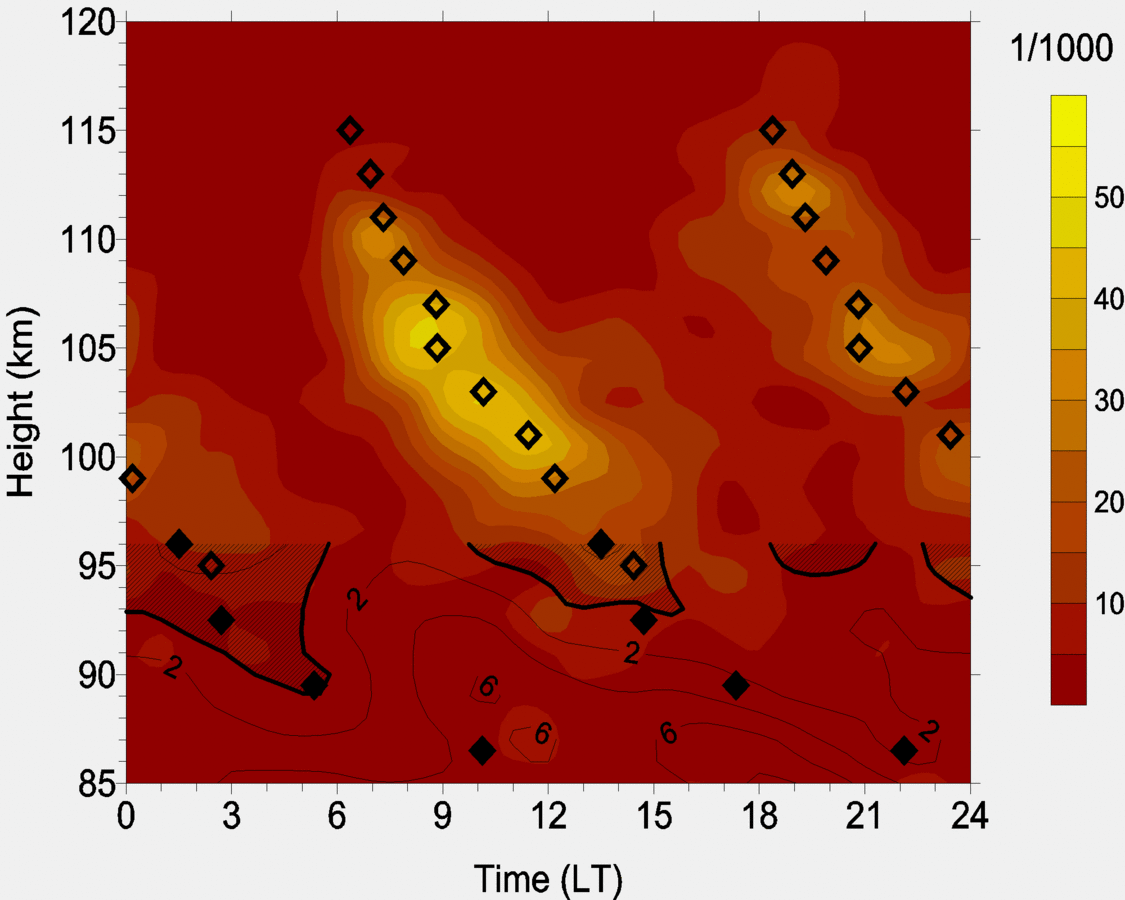
Publications within the project:
- Jacobi, Ch., and C. Arras, 2019: Tidal wind shear observed by meteor radar and comparison with sporadic E occurrence rates based on GPS radio occultation observations, Adv. Radio Sci., 17, 213-224, doi:10.5194/ars-17-213-2019.
- Jacobi, Ch., C. Arras, C. Geißler, and F. Lilienthal, 2019: Quarterdiurnal signature in sporadic E occurrence rates and comparison with neutral wind shear, Ann. Geophys.,37, 273-288, doi:10.5194/angeo-37-273-2019.
- Jacobi, Ch., and C. Arras, 2018: 6 hr tide seen in sporadic E layers, Rep. Inst. Meteorol. Univ. Leipzig 56, 11-20, ISBN: 978-3-9814401-6-4.
- Fytterer, T., C. Arras, P. Hoffmann, and Ch. Jacobi, 2014: Global distribution of the migrating terdiurnal tide seen in sporadic E occurrence frequencies obtained from GPS radio occultations, Earth, Planets and Space, 66:79, doi:10.1186/1880-5981-66-79.
- Jacobi, Ch., C. Arras, and J. Wickert, 2013: Enhanced sporadic E occurrence rates during the Geminid meteor showers 2006-2010, Adv. Radio Sci., 11. 313-318, doi:10.5194/ars-11-333-2013.
- Fytterer, T., C. Arras, and C. Jacobi, 2013: Terdiurnal signatures in sporadic E layers at midlatitudes, Adv. Radio Sci., 11, 333-339, doi:10.5194/ars-11-333-2013.
- Arras, C., J. Wickert, Ch. Jacobi, G. Beyerle, S. Heise, and T. Schmidt, 2012: Global Sporadic E Layer Characteristics Obtained from GPS Radio Occultation Measurements. In: Lübken, F.-J. (Ed.): Climate and Weather of the Sun-Earth System (CAWSES), Springer, Berlin, 207-222.
- Arras, C., J. Wickert, S. Heise, T. Schmidt, and Ch. Jacobi, 2010: Global sporadic E signatures revealed from multi-satellite radio ocultation measurements. Adv. Radio Sci., 8, 225-230, doi:10.5194/ars-8-225-2010.
- Arras, C., Ch. Jacobi, and J. Wickert, 2009: Semidiurnal tidal signature in sporadic E occurrence rates derived from GPS radio occultation measurements at midlatitudes. Ann. Geophys. 27, 2555–2563, do:10.5194/angeo-27-2555-2009.
- Arras, C., J. Wickert, G. Beyerle, S. Heise, T. Schmidt, and Ch. Jacobi, 2008: A global climatology of ionospheric irregularities derived from GPS radio occultation. Geophys. Res. Lett. 35, L14809,. doi:10.1029/2008GL034158.
Finished research projects
The projects listed below are finished subprojects of joint projects funded by the German Research Foundation and the European Union, projects for a temporary positions funded by the German Research Foundation and projects funded by the institute.
Wave coupling processes of the middle and upper atmosphere: Interannual and long-term variability (VACILT)
Funding: German Research Council (DFG)
Period: 01.07.2019 – 31.08.2022
Team: Dr. Ales Kuchar, Prof. Dr. Christoph Jacobi
Cooperation partners:
- Institute of Atmospheric Physics, Kühlungsborn
- Department of Earth and Planetary Sciences, Kyushu University
Related projects:
The long-term variations of the upper atmosphere are influenced by dynamical processes in the underlying atmosphere. These meteorological influences are mainly due to atmospheric waves propagating from the lower atmosphere to the thermosphere. Transferring energy and momentum, they modify thermospheric and ionospheric parameters. Atmospheric waves not only reflect dynamical features of the lower/middle atmosphere, but also exhibit long-term trends. Consequently, not only the widely known greenhouse gas cooling contributes to thermospheric long-term changes, but atmospheric wave trends also, and a comprehensive description of upper atmosphere trends will have to include this wave variability and trends.
To quantify the effect of lower and middle atmosphere wave coupling on upper atmosphere dynamics, VACILT aims at observing, modeling, and rigorously quantifying interannual and long-term changes of lower and middle atmosphere waves and their effects in the upper atmosphere. To this end, long-term (> 30 years) radar observations will be analyzed with respect to waves and mean circulation trends. These analyses will be compared with results of a long-term, lower atmosphere driven simulation of the GAIA Earth System Model, which in turn will be supported by the analysis of thermospheric observations.
From the GAIA analyses, the lower atmosphere forcing on the thermosphere due to waves will be quantified. The variability of this forcing will be determined and interpreted in the context of lower atmosphere variability. To substantiate the results, sensitivity experiments with a mechanistic model will be performed.
Main goals of VACILT are
- a quantitative description of interannual and long-term variability and trends in the middle atmosphere and thermosphere by analyzing the mean circulation and wave parameters from Earth System Model, supported by ground-based and satellite observations
- quantitative estimates of the degree of wave coupling effects in the upper atmosphere
- a comprehensive analysis of the role of middle-upper atmosphere wave coupling in forcing upper atmosphere long-term trends and variations, in relation to other drivers like greenhouse gas cooling.
Publikationen zum Thema VACILT:
Publications related to VACILT:
- Lilienthal, F., N. Samtleben, Ch. Jacobi, and E. Yigit, 2019: Implementing a whole atmosphere gravity wave parameterization in the Middle and Upper Atmosphere Model: Preliminary Results, Rep. Inst. Meteorol. Univ. Leipzig, 57, 59-70.
- Qian, L., Ch. Jacobi, and J. McInerney, 2019: Trends and Solar Irradiance Effects in the Mesosphere, J. Geophys. Res.: Space Physics, 124, 1343 – 1360, doi:10.1029/2018JA026367.
- Jacobi, Ch., A. Krug, and E. Merzlyakov, 2017: Radar observations of the quarterdiurnal tide at midlatitudes: Seasonal and long-term variations, J. Atmos. Sol.-Terr. Phys., 163, 70-77 doi:10.1016/j.jastp.2017.05.014.
- Jacobi, Ch., F. Lilienthal, C. Geißler, and A. Krug, 2015: Long-term variability of mid-latitude mesosphere-lower thermosphere winds over Collm (51°N, 13°E), J. Atmos. Sol.-Terr. Phys., 136, B, 174–186, doi:10.1016/j.jastp.2015.05.006.
- Jacobi, Ch., 2014: Long-term trends and decadal variability of upper mesosphere/lower thermosphere gravity waves at midlatitudes, J. Atmos. Sol.-Terr. Phys., 118, Part A, 90-95, doi:10.1016/j.jastp.2013.05.009.
Non-zonal Structures of Mesosphere/lower Thermosphere Dynamics at Middle Latitudes (NOSTHEM)
Funding: German Reserach Foundation (DFG)
Project period: 15.08.2018 – 31.07.2022
Team: Dr. Kanykei Kandieva, Prof. Dr. Christoph Jacobi
Cooperation partner:
- Department of Radiophysics,
- Institute of Physics, Kazan Federal University, Russian Federation
During NOSTHEM, longitudinal differences of mean winds, tidal parameters, and planetary and gravity waves in the mesosphere/lower thermosphere (MLT) will be analyzed and interpreted. The influence of these differences on the representativeness of single sites for describing zonal means of winds and wave parameters will be quantified. This will allow us to quantitatively estimate the uncertainty of mean climatology, long-term trends, and measures of interannual variability observed at single sites. The contribution of non-zonal structures to mean circulation and its variability will be determined. Hemispheric analyses of lower and middle atmosphere waves and circulation parameters will be used to analyze the role of these in establishing longitudinal differences. This will then resolve the question whether there is a significant difference between the mid-latitude MLT wind regimes in Western and Eastern Europe, and which are the underlying processes leading to these differences.
The NOSTHEM project will make use of the two very similar VHF meteor radar observations at similar latitude, but with a 36° difference in longitude in order to specify quantitatively the influence of non-zonal structures on mean circulation, waves and tides. In order to obtain a comprehensive picture of non-zonal structures in the MLT dynamics, the concurrent observations of winds and temperatures using VHF radars at Collm and Kazan will be completed by numerical modeling using a circulation model of the middle atmosphere, satellite observations, and reanalyses.
Main goals of NOSTHEM are (1) a quantitative description of similarities and differences of MLT circulation parameters at two longitudes, (2) an extrapolation of this analysis to the full hemispheric view based on satellite observations and modeling, and (3) a quantitative estimation of the role of waves in the specific characteristic of circulation parameters at single sites. As a final goal, we shall explain longitudinal differences through their underlying processes, and also provide guidelines for the interpretation of both mean climatology and trend analyses made at single sites in terms of their representativeness for hemispheric dynamics.
Publications related to the project:
- Merzlyakov, E., T. Solovyova, A. Yudakov, D. Korotyshkin, Ch. Jacobi, and F. Lilienthal, 2019: Some features of the day-to-day MLT wind variability in winter 2017-2018 as seen with a European/Siberian meteor radar network, Adv. Space Res., in press, doi:10.1016/j.asr.2019.12.018
- Jacobi, Ch., F. Lilienthal, G. Stober, D. Korotyshkin, and E. Merzlyakov, 2019: Mesosphere/lower thermosphere winds measured with nearby SkiYMET meteor radars at Collm and Juliusruh, and comparison with Kazan winds , IEEE Xplore, Kleinheubach Conference.
- Lilienthal, F., N. Samtleben, Ch. Jacobi, and E. Yigit, 2019: Implementing a whole atmosphere gravity wave parameterization in the Middle and Upper Atmosphere Model: Preliminary Results , Rep. Inst. Meteorol. Univ. Leipzig, 57, 59-70,
- Korotyshkin, D., E. Merzlyakov, Ch. Jacobi, F. Lilienthal, and Q. Wu., 2019: Longitudinal MLT wind structure at higher mid-latitudes as seen by meteor radars at Central and Eastern Europe (13°E/49°E), Adv. Space Res., 63, 3154-3166, doi:10.1016/j.asr.2019.01.036
- Korotyshkin, D., E. Merzlyakov, Ch. Jacobi, F. Lilienthal und Q. Wu, 2018: Longitudinal MLT wind structure at higher mid-latitudes as seen by meteor radars at Central and Eastern Europe (13°E/49°E), VCAIS 2018, 2.-6.7.2018, Potsdam.
- Korotyshkin, D.V., E.G. Merzlyakov, Ch.Jacobi und F. Lilienthal., 2018: Diurnal and seasonal temperature oscillations near 90 km as seen with SkiYMET meteor radars at Collm and Kazan,VCAIS 2018, 2.-6.7.2018, Potsdam.
Delayed response of the ionosphere to solar EUV variability (DRIVAR)
Funding: German Reseach Foundation
Period: 01.04.2017 – 30.11.2021
Team: Dr. Rajesh Ishwardas Vaishnav, Prof. Dr. Christoph Jacobi
Cooperation partner: German Aresospace Center (DLR) - Institute of Communications and Navigation
The ionospheric plasma reacts on solar EUV and UV variations in the course of the solar rotation with a time delay of 1-2 days. This delay is assumed to be owing to transport processes from the lower ionosphere to the F region, but only limited modeling has been performed so far to prove this hypothesis.
Within DRIVAR, the processes responsible for the ionospheric delay will be investigated through comprehensive data analyses and modeling. Different kinds of solar proxies as well as spectral EUV and UV fluxes from satellite observations will be used and analyzed together with ionospheric parameters from GPS radio occultations and ionosondes, and, providing both global and high-resolution coverage, GPS total electron content maps. In particular, the ionospheric delay will be analyzed at different time scales (short-term, solar rotation, seasonal time scale), and the regional dependence of the delay will be analyzed.
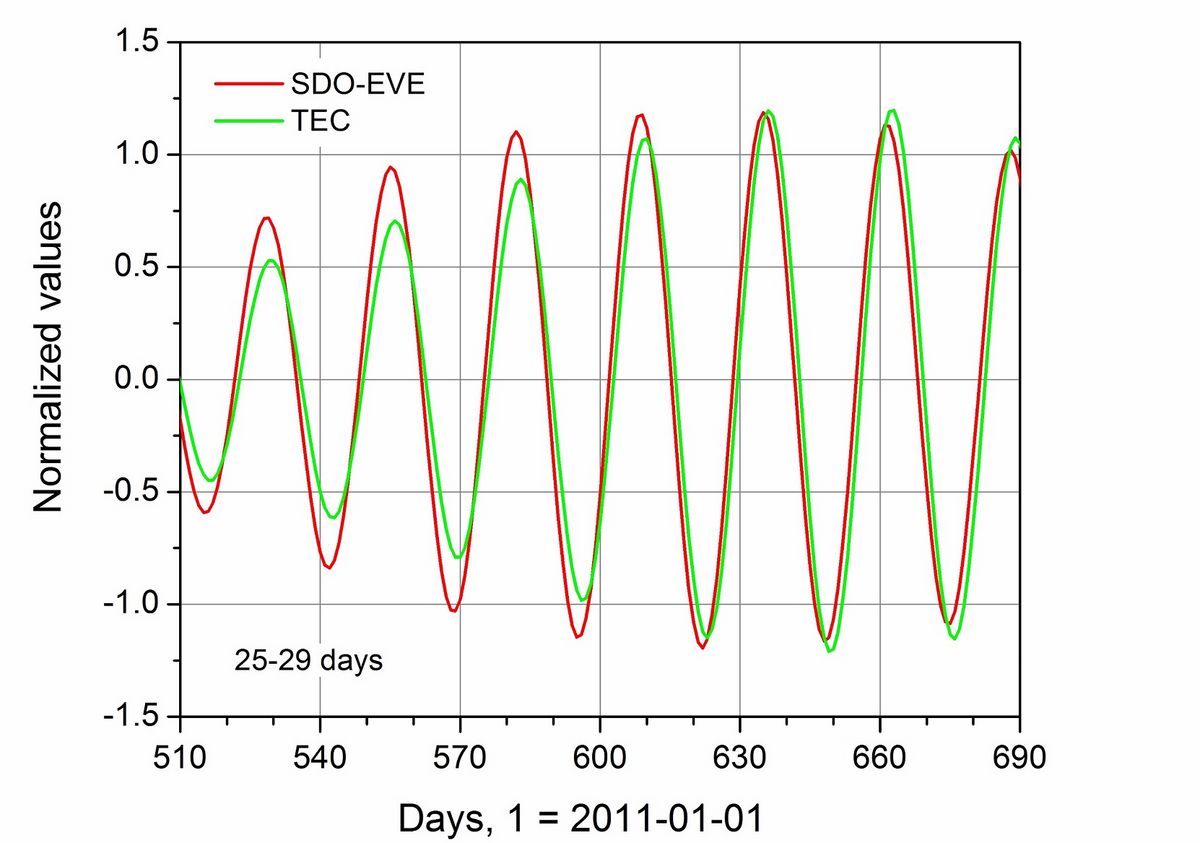
The DRIVAR results will provide more insight into ionospheric processes in general, and will be most valuable for ionospheric applications in forecasting ionospheric weather, e.g. for the use in GNSS error analyses and predictions.
Due to the complex character of numerous interacting processes in the thermosphere and ionosphere numerical modeling is required to physically understand the basic processes contributing to the delay. We shall use the Coupled Thermosphere Ionosphere Plasmasphere Electrodynamics (CTIPe) model to simulate the delay and, through sensitivity experiments, investigate and analyze in detail the processes that lead to the observed delay.
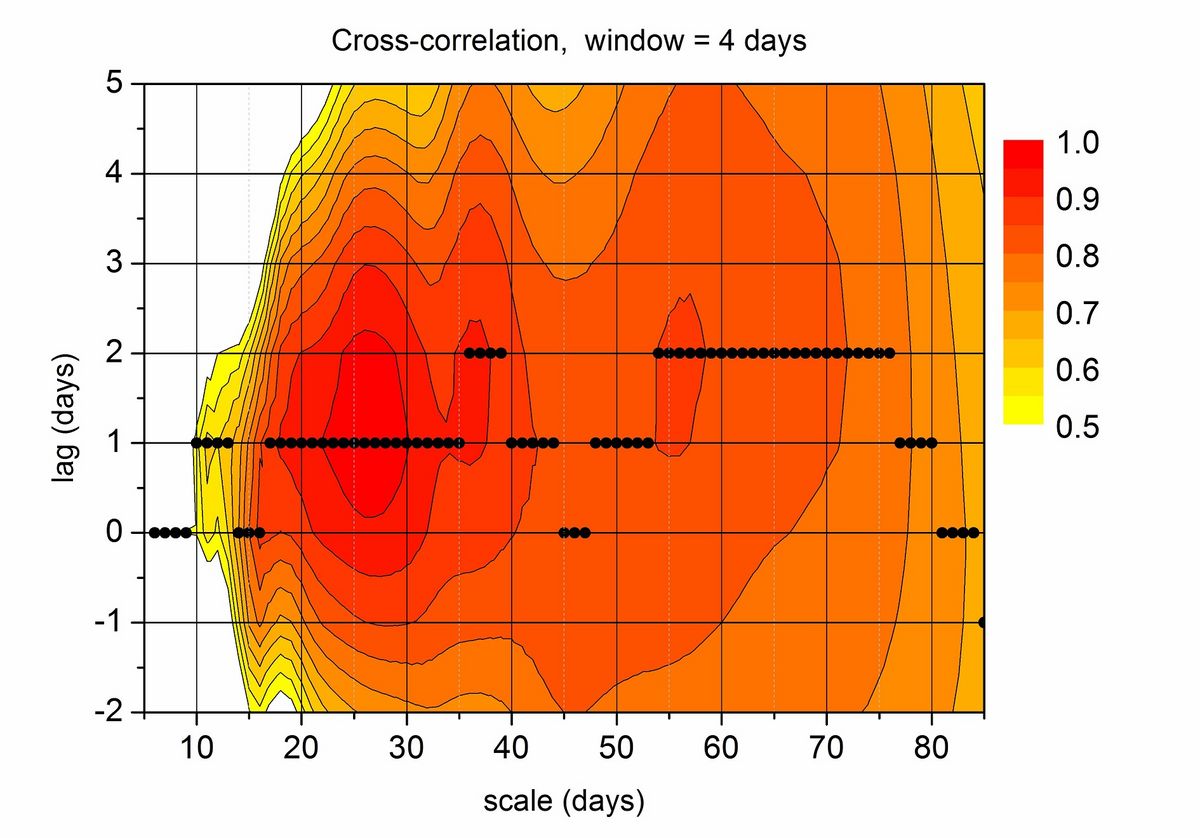
Publications related to the project:
- Schmölter, E., J. Berdermann, N. Jakowski, and Ch. Jacobi, 2020: Spatial and seasonal effects on the delayed ionospheric response to solar EUV changes, Ann. Geophys., 38, 149–162, doi:10.5194/angeo-38-149-2020.
- Vaishnav, R., Ch. Jacobi, and J. Berdermann, 2019: Long-term trends in the ionospheric response to solar EUV variations, Ann. Geophys., 37, 1141-1159, doi:10.5194/angeo-37-1141-2019.
- Vaishnav, R., Ch. Jacobi, J. Berdermann, E. Schmölter, and M. Codrescu, 2018: Ionospheric response to solar EUV variations: Preliminary results, Adv. Radio Sci., 16, 157-165, doi:10.5194/ars-16-157-2018.
- Schmölter, E., J. Berdermann, N. Jakowski, Ch. Jacobi, and R.I. Vaishnav, 2018: Delayed response of the ionosphere to solar EUV variabilities, Adv. Radio Sci., 6, 149-155, doi:10.5194/ars-16-149-2018.
- Vaishnav, R., Ch. Jacobi, J. Berdermann, E. Schmölter, and M. Codrescu, 2018: Ionospheric response during low and high solar activity, Rep. Inst. Meteorol. Univ. Leipzig 56, 1-10, ISBN: 978-3-9814401-6-4, urn:nbn:de:bsz:15-qucosa2-317670.
- Jacobi, Ch., N. Jakowski, G. Schmidtke, and T.N. Woods, 2016: Delayed response of the global total electron content to solar EUV variations, Adv. Radio Sci., 14, 175-180, doi:10.5194/ars-14-175-2016.
- Jacobi, Ch., C. Unglaub, G. Schmidtke, Schäfer, and N. Jakowski, 2015: Delayed response of global ionospheric electron content to EUV variations derived from combined SolACES-SDO/EVE measurements, Rep. Inst. Meteorol. Univ. Leipzig, 53, 1 - 10. urn:nbn:de:bsz:15-qucosa2-166458.
- Jacobi, Ch., C. Unglaub, G. Schmidtke, M. Pfeifer, R. Schäfer, R. Brunner, T. Woods, und N. Jakowski, 2015: Delayed response of global TEC to ionization variations seen from combined SolACES-SDO/EVE solar EUV spectra, Proc. 7. Workshop "Solar Influences on the Magnetosphere, Ionosphere and Atmosphere", 1.-5.6.2015, Sunny Beach, 29-32, ISSN 2367-7570.
Middle atmosphere effects of localized gravity wave forcing (MATELO)
Funding: German Reseach Foundation
Project period: 01.01 2017 – 31.03.2020
Cooperation partner: Department of Atmospheric Physics, Faculty of Mathematics and Physics, Charles University in Prague (Prof. P. Pišoft)
The project involves a study of the middle atmosphere effects of localized internal gravity wave (IGW) forcing. Characteristics of the higher IGW activity regions, their spatial and temporal variability and links to other climate factors will be studied using GPS radio occultations. We will implement algorithms for full 3D diagnostics of the wave forcing and Brewer-Dobson circulation (BDC). The diagnostics will be applied along with numerical simulations of a mechanistic circulation model and reanalysis data in order to specify the BDC longitudinal variability and the role of the localized IGW forcing. In the next step, we will study the generation and propagation directions of planetary waves forced by the localized IGW forcing. Implications for the polar regions (circulation perturbations, winter preconditioning, sudden stratospheric warming characteristics), equatorial stratosphere (tropopause folds links, influence on the exchange with the troposphere) and mesosphere will be studied using the numerical simulations. The results will be evaluated in the context of the global middle atmospheric mean circulation and its variability.
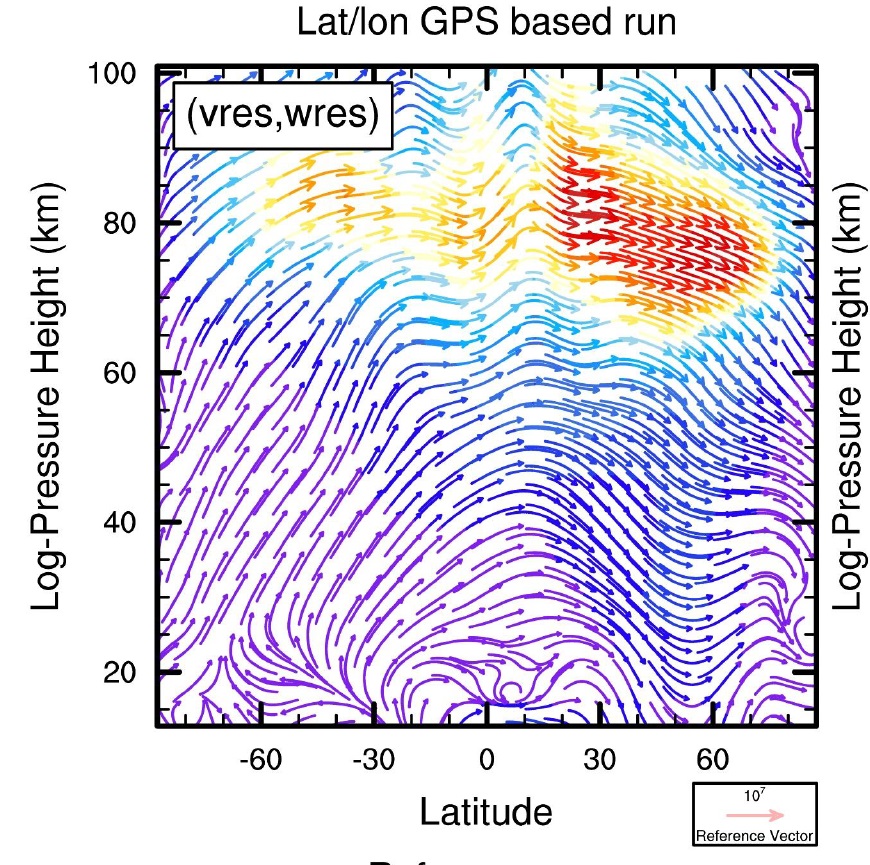
Publications related to the project:
- Samtleben, N., A. Kuchar, P. Šácha, P. Pišoft, and Ch. Jacobi, 2020: Impact of local gravity wave forcing in the lower stratosphere on the polar vortex stability: Effect of longitudinal displacement, Ann. Geophys., 38, 95-108, doi:10.5194/angeo-38-95-2020.
- Lilienthal, F., N. Samtleben, Ch. Jacobi, and E. Yigit, 2019: Implementing a whole atmosphere gravity wave parameterization in the Middle and Upper Atmosphere Model : Preliminary Results, Rep. Inst. Meteorol. Univ. Leipzig, 57, 59-70,
- Samtleben, N., Ch. Jacobi, P. Pišoft, P. Šácha, and A. Kuchar, 2019: Effect of latitudinally displaced gravity wave forcing in the lower stratosphere on the polar vortex stability, Ann. Geophys., 37, 507-523, doi:10.5194/angeo-37-507-2019.
- Samtleben N., and Ch. Jacobi, 2018: Impact of intermittent gravity wave activity on the middle atmospheric circulation during boreal winter , Rep. Inst. Meteorol. Univ. Leipzig, 56, 31-44, ISBN: 978-3-9814401-6-4,
- Šácha, P., F. Lilienthal, Ch. Jacobi, and P. Pišoft, 2016: Influence of the spatial distribution of gravity wave activity on the middle atmospheric circulation and transport, Atmos. Chem. Phys., 16, 15755-15775, doi:10.5194/acp-16-15755-2016.
- Šácha, P., A. Kuchar, Ch. Jacobi, and P. Pišoft, 2015: Enhanced internal gravity wave activity and breaking over the Northeastern Pacific / Eastern Asian region, Atmos. Chem. Phys., 15, 13097-13112, doi:10.5194/acp-15-13097-2015.
- Šácha, P., P. Pišoft, F. Lilienthal, and Ch. Jacobi, 2015: Internal gravity wave activity hotspot and implications for the middle atmospheric dynamics. In: L. Ouwehand (Ed.), Proceedings of ATMOS 2015, 8.-12.6.2015, Heraklion, ESA SP-735, ISBN: 978-92-9221-299-5, id.16.
- Lilienthal, F., P. Šácha, and Ch. Jacobi, 2015: Gravity wave effects on a modeled mean circulation, Rep. Inst. Meteorol. Univ. Leipzig, 53, 11 - 22
Quarterdiurnal tide in the middle atmosphere (QuarTA)
Funding: German Reseach Foundation
Project period: 01.01.2017 – 31.03.2020
Cooperation partners:
- Institute for Experimental Meteorology, Obninsk, Russia (Dr. E. Merzlyakov)
- Helmholtz Centre Potsdam - GFZ German Research Centre for Geosciences (Dr. C. Arras)
The dynamics of the mesosphere and lower thermosphere (MLT) is strongly determined by solar tides and their variability. One of the tidal components is the quarterdiurnal tide (QTD), which has occasionally been reported in ionospheric sporadic E parameters and radar and few satellite observations. While the diurnal, semidiurnal, and also terdiurnal tidal components have been analyzed more frequently, the QDT hast attained much less attention, mainly owing to its smaller amplitudes, which makes observations more difficult.
To fill this gap, within QuarTA the QDT and its forcing mechanisms are analyzed in detail. The characteristics of the tide in MLT dynamics is analyzed using meteor radar winds, in particular making use of the long-term data set at Collm, Germany, in combination with other Northern Hemisphere radar observations. The global structure of the QDT is analyzed in sporadic E occurrence rates obtained from GPS radio occultations complemented by ionosonde observations. These observations are interpreted by wind shear observed by radar and obtained from numerical modelling.
To get insight into the forcing mechanisms of the QDT, we use a mechanistic circulation model of the middle atmosphere, which includes nonlinear interaction processes as well as radiative forcing. In sensitivity experiments, the different forcing mechanisms are turned off both separately and in combination.
Within QuarTA, from combining local and global observations with numerical modelling, we therefore expect to get more insight into the global structure of the QDT as well as into its forcing processes, which have not yet been analyzed in sufficient detail.
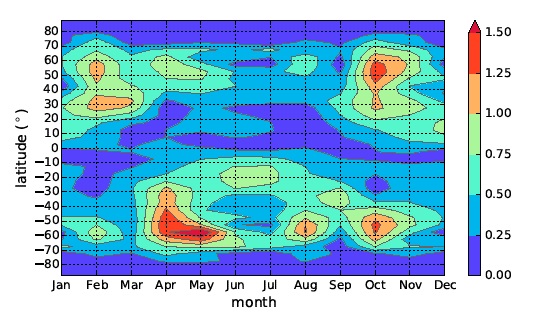
Publications related to the project:
- Geißler, C., Ch. Jacobi, and F. Lilienthal, 2020: Forcing mechanisms of the migrating quarterdiurnal tide, Ann. Geophys., 38, 527–544, doi:10.5194/angeo-38-527-2020.
- Jacobi, Ch., and C. Arras, 2019: Tidal wind shear observed by meteor radar and comparison with sporadic E occurrence rates based on GPS radio occultation observations, Adv. Radio Sci., 17, 213-224, doi:10.5194/ars-17-213-2019. doi:10.5194/ars-17-213-2019.
- Löffelmann, J., F. Lilienthal, and Ch. Jacobi, 2019: Trend analyses of solar tides in the middle atmosphere , Rep. Inst. Meteorol. Univ. Leipzig, 57, 71-84, Zum Artikel
- Jacobi, Ch., C. Arras, C. Geißler, and F. Lilienthal, 2019: Quarterdiurnal signature in sporadic E occurrence rates and comparison with neutral wind shear, Ann. Geophys.,37, 273-288, doi:10.5194/angeo-37-273-2019.
- Jacobi, Ch., C. Geißler, F. Lilienthal, and A. Krug, 2018: Forcing mechanisms of the 6-hour tide in the mesosphere/lower thermosphere, Adv. Radio Sci., 16, 141-147, doi:10.5194/ars-16-141-2018.
- Jacobi, Ch., and C. Arras, 2018: 6 hr tide seen in sporadic E layers, Rep. Inst. Meteorol. Univ. Leipzig 56, 11-20, ISBN: 978-3-9814401-6-4, urn:nbn:de:bsz:15-qucosa2-317680.
- Geißler, Ch., and Ch. Jacobi, 2018: Forcing of the Quarterdiurnal Tide, Rep. Inst. Meteorol. Univ. Leipzig, 56, 21-30, ISBN: 978-3-9814401-6-4, urn:nbn:de:bsz:15-qucosa2-317929.
- Jacobi, Ch., A. Krug, and E. Merzlyakov, 2017: Radar observations of the quarterdiurnal tide at midlatitudes: Seasonal and long-term variations, J. Atmos. Sol.-Terr. Phys., 163, 70-77, doi:10.1016/j.jastp.2017.05.014.
- Jacobi, Ch., A. Krug, and E.G. Merzlyakov, 2016: Radar wind climatology of the quarterdiurnal tide in the mesopause region over Central and Eastern Europe, Rep. Inst. Meteorol. Univ. Leipzig, 54, 47-56, ISBN: 978-3-9814401-4-0, urn:nbn:de:bsz:15-qucosa2-167047.
- Jacobi, Ch., A. Krug, F. Lilienthal, L. M. Lima und E. Merzlyakov, 2016: Radar observations of the quarterdiurnal tide in the mesosphere/lower thermosphere, EGU General Assembly 2016, 17.-22.4.2016, Vienna.
Terdiurnal tide in the middle atmosphere
Funding: German Reseach Foundation
Project period: 2014 – 2018
Cooperation partner: RSHU St. Petersburg
A nonlinear mechanistic circulation model of the middle atmosphere is used to analyse the forcing mechanisms of the terdiurnal tide in the middle atmosphere.
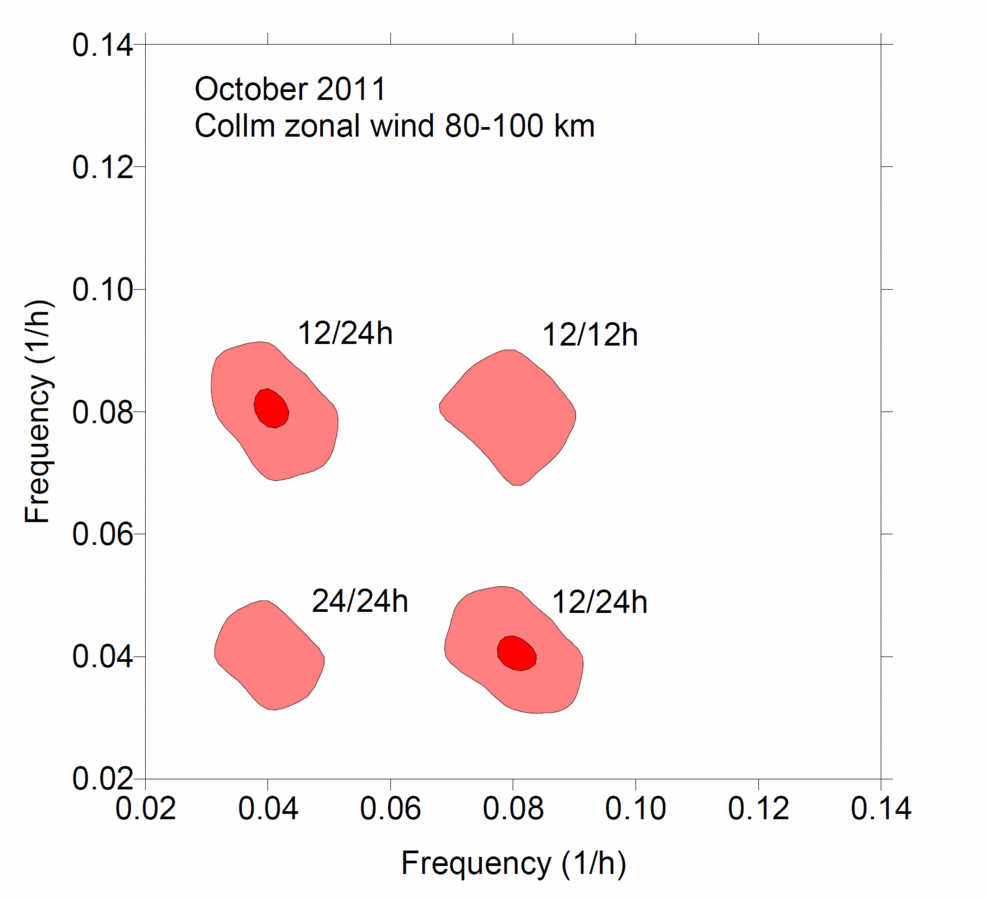
The used model MUAM (Middle and Upper Atmosphere Model) includes a full radiation parameterization scheme and is therefore capable to reproduce the terdiurnal tide. To analyse the forcing mechanisms, direct forcing through the 8-hour component of the diurnal solar forcing, and nonlinear interaction of the diurnal and semidiurnal in the advection terms in the momentum equations is analyzed. The work is completed by radar and satellite data analyses.
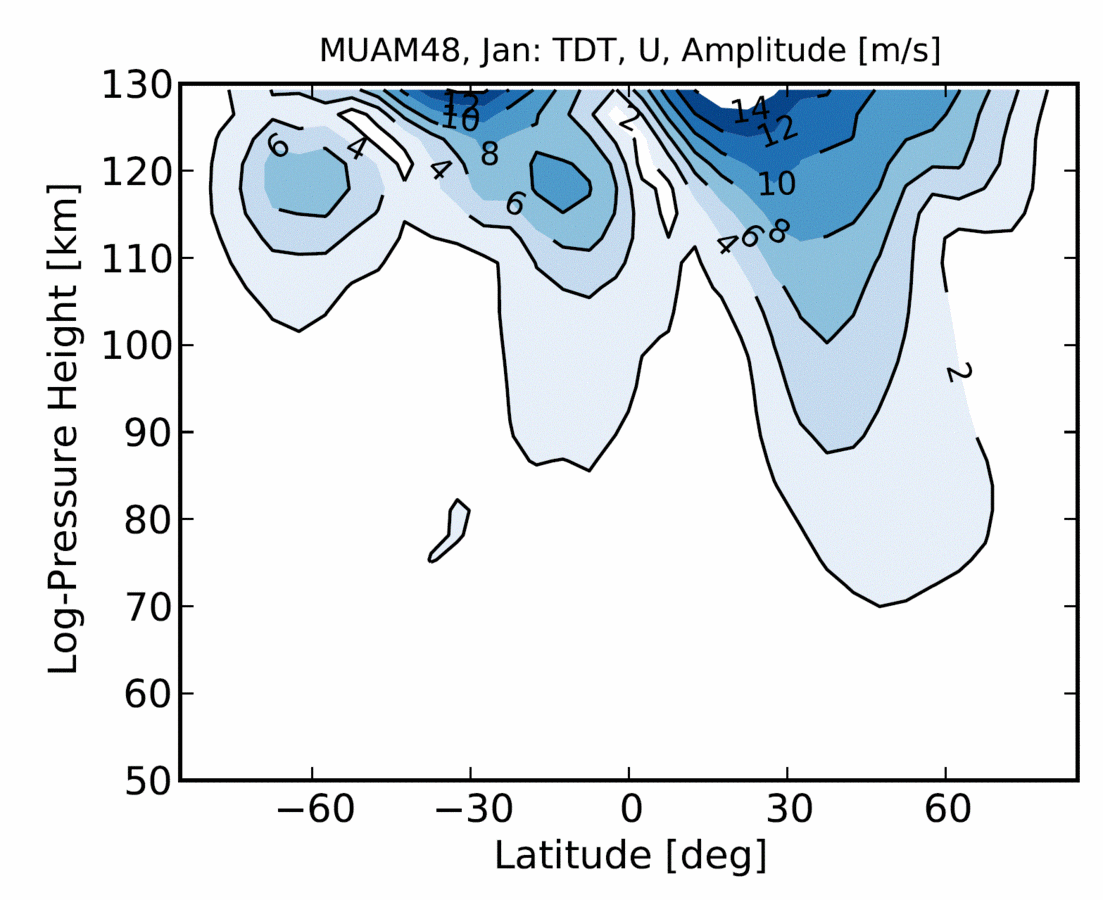
- Lilienthal, F., and Ch. Jacobi, 2019: Nonlinear forcing mechanisms of the terdiurnal solar tide and their impact on the zonal mean circulation, Ann. Geophys., 37, 943-953, doi:10.5194/angeo-37-943-2019.
- Jacobi, Ch., and C. Arras, 2019: Tidal wind shear observed by meteor radar and comparison with sporadic E occurrence rates based on GPS radio occultation observations, Adv. Radio Sci., 17, 213-224, doi:10.5194/ars-17-213-2019.
- Lilienthal, F., Ch. Jacobi, and C. Geißler, 2018: Forcing mechanisms of the terdiurnal tide, Atmos. Chem. Phys., 18, 15725-15742, doi:10.5194/acp-18-15725-2018.
- Lilienthal, F., und Ch. Jacobi, 2016: The Role of Solar Heating in the Forcing of the Terdiurnal Tide, Rep. Inst. Meteorol. Univ. Leipzig, 54, 57-66, ISBN: 978-3-9814401-4-0, urn:nbn:de:bsz:15-qucosa2-167051.
- Krug, A., F. Lilienthal, and Ch. Jacobi, 2015: The terdiurnal tide in the MUAM circulation model, Rep. Inst. Meteorol. Univ. Leipzig, 53, 33 - 44, urn:nbn:de:bsz:15-qucosa2-166502.
- Fytterer, T., C. Arras, P. Hoffmann, and Ch. Jacobi, 2014: Global distribution of the migrating terdiurnal tide seen in sporadic E occurrence frequencies obtained from GPS radio occultations, Earth, Planets and Space, 66:79, doi:10.1186/1880-5981-66-79.
- Jacobi, Ch., and T. Fytterer, 2013: Climatology of the 8-hour solar tide over Central Europe, Collm (51.3°N; 13.0°E). Proceedings of MST-13, 175-179.
- Fytterer, T., C. Arras, and Ch. Jacobi, 2013: Terdiurnal signatures in midlatitude sporadic E layers occurrence rates, Rep. Inst. Meteorol. Univ. Leipzig, 51, 25-38, urn:nbn:de:bsz:15-qucosa2-164090.
- Fytterer, T., C. Arras, and C. Jacobi, 2013: Terdiurnal signatures in sporadic E layers at midlatitudes, Adv. Radio Sci., 11, 333-339, doi:10.5194/ars-11-333-2013.
Atmospheric Gravity Waves - Observation and Modeling (A-G-W-O-M)
Funding: Federal Minitry of Education and Research (BMBF)
Period: 2014 – 2017
Cooperation partner:
- GFZ Potsdam (Dr. T. Schmidt),
- Austral-University Buenos Aires/Pilar (Prof. A de la Torre)
The project aimed at quantitatively determining gravity wave parameters in stratosphere and ionosphere using GNSS radio occultations, and modeling of gravity wave propagation and impact on the atmosphere and ionosphere using the MUAM middle atmosphere model of the Leipzig Institute of Meteorology
Publications related to the project:
- Lilienthal, F., Ch. Jacobi, T. Schmidt, A. de la Torre, and P. Alexander, 2017: On the influence of zonal gravity wave distributions on the Southern Hemisphere winter circulation, Ann. Geophys., 35, 785-798, doi:0.5194/angeo-35-785-2017.
- Jacobi, Ch., F. Lilienthal, T. Schmidt, and A. de la Torre, 2016: Modeling the Southern Hemisphere winter circulation using realistic zonal mean gravity wave information in the lower atmosphere , Rep. Inst. Meteorol. Univ. Leipzig, 54, 37-46, ISBN: 978-3-9814401-4-0.
- Schmidt, T., A. de la Torre, P. Llamedo, P. Alexander, F. Lilienthal, C. Jacobi, J. Wickert. 2015: Long-term observations of gravity wave activity in the lower stratosphere with GPS radio occultation data, IUGG 26th Assembly, 22.6.-2.7.2015, Prague.
- Ern, M., C. Arras, A. Faber, K. Fröhlich, Ch. Jacobi, S. Kalisch, M. Krebsbach, P. Preusse, T. Schmidt und J. Wickert, 2013: Observations and Ray Tracing of Gravity Waves: Implications for Global Modeling. In: Lübken, F.-J. (Hrsg.): Climate and Weather of the Sun-Earth System (CAWSES), Springer, Berlin, 383-408, doi: 10.1007/978-94-007-4348-9_21.
- Fröhlich, K., T. Schmidt, M. Ern, P. Preusse, A. de la Torre, J. Wickert, and Ch. Jacobi, 2007: The global distribution of gravity wave energy in the lower stratosphere derived from GPS data and gravity wave modelling: attempt and challenges, J. Atmos. Sol.-Terr. Phys., 69, 2238–2248.
Empirical and semiempirical models of middle atmosphere wind and wind variability
Period: 2004 – 2006
Partnership
We are 4 partners from 3 European countries, all of us regularly involved in mesosphere/lower thermosphere (MLT) dynamics science, and carrying out MLT and measurements:
- Institute for Meteorology, University of Leipzig, Germany
- Institute for Experimental Meteorology, Russia
- Radiophysics Department, Kazan State University, Russia
- Hovemere Ltd., UK
Summary
The research programme contains the construction of global, monthly tables of wind and its variability in the atmosphere up to 100 km. This task is based on already existing models of winds and tides in the mesosphere/lower thermosphere, uses global analyses from Met Office reanalyses, and combines these analyses using a circulation model to include the mesosphere that is not well covered with measurements.
In summary, the project research programme consisted of the following tasks:
- Update of the mesosphere/lower thermosphere empirical mean wind model
- Construction of a stratospheric mean wind model
- Including stationary planetary waves in models
- Calculating the degree of variability of winds
- Construction of a semiempirical model of the entire middle atmosphere, through assimilation of the zonal mean winds into a circulation model
- Validation or the results using ground-based and space-based measurements
The project combined the efforts of 2 INTAS and 2 NIS partners, each having long experience in establishing empirical climatologies of the middle atmosphere, ground-based and space-based measurements and numerical modelling. The length of the project was 30 months. During this time interval an important step towards new and updated reference models were performed.
Contact:
Data sheets: Prof. Dr. Christoph Jacobi
Solar EUV measurements and ionospheric response
The project bases on a cooperation between
- Universität Leipzig, Institut of Meteorology,
- DLR-Institute of Communications and Navigation, Neustrelitz,
- Fraunhofer-Institute for Physical Measurement Techniques (IPM), Freiburg.
The SolACES project is led by IPM.
The SolACES spectrometers continuously monitors the EUV/UV radiation of the sun in the wavelength range between 17 and 220 nm onboard the ISS (DLR, 2006). SolACES is part of the SOLAR space science instrument package. The instruments are directed towards the sun.
The primary scientific goal of SolACES is to observe the spectral irradiance of the sun and its variation with time. The spectral resolution of these measurements will vary between 0.5 and 2 nm depending on wavelength. A novel feature of SolACES is its capability to auto-calibrate the instrument during the mission. EUV fluxes are anticipated to be measured with an absolute radiometric accuracy of better than 10%.
A main goal of the project is to experimentally describe the response of the ionospheric electron density on mid-term solar flux changes. This requires the following analyses:
- Investigation of the solar irradiance and its variability in the EUV range based upon SolACES EUV measurements
- Investigation of the reaction of the neutral upper atmosphere composition, temperature and dynamics on variations in EUV flux using numerical models of the mesosphere/thermosphere
- Statistical study of the ionospheric response on EUV variations and EUV bursts using TEC data derived by ground and space based GPS measurements
- Modelling the time delay between EUV variations and the ionospheric response as indicated qualitatively by TEC time series
As a result, a comprehensive and detailed picture of the ionospheric response to EUV variations will be given. Co-products are a data base of EUV variations, EUV/TEC correlations, and numerical model results of the undisturbed and disturbed thermosphere/ionosphere system for the duration of the SolACES measurement campaign.
Publications with scientific quality assurance
- Schmidtke, G., S.V. Avakyan, J. Berdermann, V. Bothmer, G. Cessateur, L. Ciraolo, L. Didkovsky, T. Dudoc de Wit, F.G. Eparvier, A. Gottwald, M. Haberreiter, R. Hammer, Ch. Jacobi, N. Jakowski, M. Kretzschmar, J. Lilensten, M. Pfeifer, S.M. Radicella, R. Schäfer, W. Schmidt, S.C. Solomon, G. Thuillier, W. K. Tobiska, S. Wieman, and T.N. Woods, 2015: Where does the Thermospheric Ionospheric GEospheric Research (TIGER) Program go? Adv. Space Res., 56, 1547–1577, doi:10.1016/j.asr.2015.07.043.
- Schmidtke, G., Ch. Jacobi, B. Nikutowski, and Ch. Erhardt, 2014: Extreme ultraviolet (EUV) solar spectral irradiance (SSI) for ionospheric application - history and contemporary state-of-art, Adv. Radio Sci., 12, 251-260, doi:10.5194/ars-12-251-2014.
- Schmidtke, G., B. Nikutowski, Ch. Jacobi, R. Brunner, Ch. Erhardt, S. Knecht, J. Scherle and J. Schlagenhauf, 2014: Solar EUV irradiance measurements by the Auto-Calibrating EUV Spectrometers (SolACES) aboard the International Space Station (ISS), Solar Phys., 289, 1863-1883, doi: 10.1007/s11207-013-0430-5.
- Unglaub, C., Ch. Jacobi, G. Schmidtke, B. Nikutowski and R. Brunner, 2012: EUV-TEC proxy to describe ionospheric variability using satellite-borne solar EUV measurements. Adv. Radio Sci., 10, 259-263.
- Unglaub, C., Ch. Jacobi, G. Schmidtke, B. Nikutowski and R. Brunner, 2011: EUV-TEC proxy to describe ionospheric variability using satellite-borne solar EUV measurements: first results. Adv. Space Res., 47, 1578-1584, doi:10.1016/j.asr.2010.12.014.
Other publications
- Jacobi, Ch., C. Unglaub, G. Schmidtke, Schäfer, and N. Jakowski, 2015: Delayed response of global ionospheric electron content to EUV variations derived from combined SolACES-SDO/EVE measurements, Rep. Inst. Meteorol. Univ. Leipzig, 53, 1 - 10, LIM Band 53
- Jacobi, Ch., C. Unglaub, G. Schmidtke, M. Pfeifer, R. Schäfer, R. Brunner, T. Woods, and N. Jakowski, 2015: Delayed response of global TEC to ionization variations seen from combined SolACES-SDO/EVE solar EUV spectra, Proc. 7. Workshop "Solar Influences on the Magnetosphere, Ionosphere and Atmosphere", 1.-5.6.2015, Sunny Beach, 29-32, ISSN 2367-7570.
- Jacobi, Ch., B. Nikutowski, J. Hein, C. Unglaub, Ch. Erhardt, R. Brunner and G. Schmidtke, 2014: Solar activity and ionospheric response as seen from combined SolACES and SDO-EVE solar EUV spectra, Wiss. Mitteil. Inst. f. Meteorol. Univ. Leipzig, 52, 49 - 56.
- Unglaub, C., Ch. Jacobi, G. Schmidtke, B. Nikutowski and R. Brunner, 2012: Proxies to describe ionospheric variability and heating rates of the upper atmosphere: current progress, Wiss. Mitt. Inst. f. Meteorol. Univ. Leipzig, 48, 45-54.
- Unglaub, C., Ch. Jacobi, G. Schmidtke, B. Nikutowski, and R. Brunner, 2010: EUV-TEC - an index to describe ionospheric variability using satellite-borne solar EUV measurements: first results. Wiss. Mitt. Inst. f. Meteorol. Univ. Leipzig 47, 51-60.
- Unglaub, C., 2010: EUV-TEC: Ein Index zur Beschreibung der ionosphärischen Variabilität, Diplom Thesis, Universität Leipzig, 104S.
Conference contributions
- Jacobi, Ch., N. Jakowski, G. Schmidtke und T.N. Woods, 2015: Delayed response of the global total electron content to solar EUV variations, Kleinheubacher Tagung 2015, 27.-29.9.2015, Miltenberg.
- Jacobi, Ch., C. Unglaub, G. Schmidtke, R. Brunner, R. Schäfer, T. Woods and N. Jakowski, 2015: Ionospheric ionization calculated from combined SolACES-SDO/EVE solar EUV spectra and comparison with delayed global TEC, IUGG 26th Assembly, 22.6.-2.7.2015, Prague.
- Jacobi, Ch., C. Unglaub, G. Schmidtke, M. Pfeifer, R. Schäfer, R. Brunner, T. Woods, and N. Jakowski, 2015: Delayed response of global TEC to ionization variations seen from combined SolACES-SDO/EVE solar EUV spectra, 7. Workshop "Solar Influences on the Magnetosphere, Ionosphere and Atmosphere", Sunny Beach, Bulgaria, 1-5 Juni 2015.
- Jacobi, Ch., R. Schäfer, and N. Jakowski, 2015: Delayed response of ionospheric electron content to solar EUV variations at different time scales, 4. Nationaler Weltraumwetterworkshop,11.-13.5.2015, DLR, Neustrelitz.
- Jacobi, Ch., C. Unglaub, G. Schmidtke, R. Schäfer, R. Brunner, T. Woods and N. Jakowski, 2015: Ionospheric ionization calculated from combined SolACES-SDO/EVE solar EUV spectra and comparison with global TEC at different time scales, EGU General Assembly 2015, Vienna, Austria, 12 – 17 April 2015.
- Schmidtke, G., F.G. Eparvier, C. Erhardt, Ch. Jacobi, N. Jakowski, B. Nikutowski, M. Pfeifer, R. Schäfer, E. Schmölter, G. Thullier and W.K. Tobiska, 2014: Where goes TIGER? 40th COSPAR Scientific Assembly, Moscow, Russia, 2.-10. August 2014.
- Jacobi, Ch., C. Unglaub, B. Nikutowski, R. Brunner, C. Erhardt and G. Schmidtke, 2013: EUV monitoring with SolACES during half of a solar cycle, IAGA 2013 XII Scientific Assembly, Merida, Mexiko, 26.-31. August 2013.
- Schmidtke, G., B. Nikutowski, R. Brunner, G. Thuillier, C. Erhardt, F. Eparvier, T. Woods, and Ch. Jacobi, 2012: Results from the SolACES instrument onboard the International Space Station (ISS). 39th COSPAR Scientific Assembly, Mysore, Indien, 14.-22.7.2012.
- Jacobi, Ch., C. Unglaub, G. Schmidtke, B. Nikutowski and R. Brunner, 2012: Primary ionisation and solar heating variability of the thermosphere using satellite-borne solar EUV measurements. DPG-Frühjahrstagung 2012, SAMOP, Stuttgart,12.-16.3.2012, Verhandlungen der Deutschen Physikalischen Gesellschaft 2/2012, S. 85.
- Unglaub, C., Ch. Jacobi, G. Schmidtke, B. Nikutowski and R. Brunner, 2011: EUV-TEC proxy for primary ionisation variability using satellite-borne solar EUV measurements. Kleinheubacher Tagung 2011, 26. – 18. September 2011, Miltenberg.
- Unglaub, C., Ch. Jacobi, P. Hoffmann, M. Placke und G. Stober, 2011: Midlatitude mesosphere/lower thermosphere parameters during solar minimum 23/24. IUGG 2011 Assembly, 28.6.-7.7.2011, Melbourne.
- Jacobi, Ch., C. Unglaub, G. Schmidtke, B. Nikutowski and R. Brunner., 2011: EUV-TEC proxy for ionospheric variability using satellite-borne solar EUV measurements. IUGG 2011 Assembly, 28.6.-7.7.2011, Melbourne.
- Unglaub, C., Ch. Jacobi, G. Schmidtke, B. Nikutowski, and R. Brunner, 2010: EUV-TEC index to describe ionospheric variability using satellite-borne solar EUV measurements: first results. COSPAR 2010, Bremen, 18-25.7.2010.
- Nikutowski, B., R. Brunner, Ch. Jacobi, S. Knecht, C. Ehrhardt, and G. Schmidtke, 2010: SolACES spectrometers onboard the International Space Station (ISS). COSPAR 2010, Bremen, 18-25.7.2010.
- Unglaub, C., Ch. Jacobi, G. Schmidtke, B. Nikutowski, and R. Brunner, 2010: An index to describe global ionospheric variability using satellite-borne solar EUV measurements. SCOSTEP STP-12 Symposium, Berlin, 12.-16.7.2010.
- Jacobi, Ch., and N. Jakowski, 2009: EUV Indices, and global TEC. EUV-IR Irradiance Workshop, IPM Freiburg, 15-17.4.2009.
